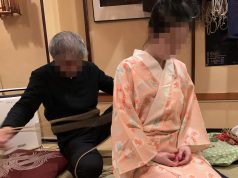Recently I had the chance to go through a workshop completely dedicated only to floorwork and partials. I am used to doing Kinbaku classes even of 3,4,5 days in a row. Including hard suspensions and transitions.
But that workshop left me completely drained.
I collected the feedback of other models, and they confirmed the same feeling: they found it extremely more challenging and tiring than the others.
So I took some time to reflect about the main feelings and emotions that are actuated during our floorwork ties.
When in suspension, I feel space and air around me. Not touching the ground, even if I am in a very constrictive tie, anyway I feel elevated, and this makes me feel closer to the sky, let’s say that it favors a sense of rise.
When in a floor tie, especially a very crunched position, I feel the touch of the ground on my body. The perception is much more similar to being buried alive in a crave.
‘It’s like progressively invisible walls are built around me, and this increases the sensation of not being able to escape. It’s an amplification of the feeling of inexorability that I have when I am tied and suspended.
I am no more elevated, instead I feel “weighed down”. Thus being forced to be aware of any tension and resistance.
I go closer to a dark underground. To hell, maybe, to my personal hell.
The predicament positions created often in a floor tie amplify the sense of bother, as whatever I try to move in order to adjust or to find a better position, can actually worsen the situation. But I must process that resistance and transform it.
So I try to struggle and to get relief, but instead, I usually end up increasing the perception of all the boring stimula, until I reach an edge where I have only two choices: going on fighting, and maintain control, or even bratting (and this can lead even to rage or to panic attacks), or let go completely and accept to surrender, and almost, to die.
When I can switch off my fighting mode, and silence my full of fear brain, I slow down my breathing and accept. I start to manage that only little space in my ribcage I have left to breathe, and I suddenly feel that I can stay there, even if I do not have range of movement. I can just patiently wait.
While in suspension I usually deal more with backbends and inversions, while in our floor ties I find myself more often in crunched and twisted positions. I have the feeling that those positions force me more to be focused on my inner side, as I have no real possibility to search for relief or comfort from the outer space.
Or, for example, in a full body lacing tie, where I am standing all time and I am progressively wrapped with lots of loops in a slow and rising constriction, even the different attitude of the rigger impacts in a different way on my reaction. I think that when the rigger is tying in a suspension or doing transitions, it’s like he’s having different points of attention/focus, they change as the tie evolves in different orientations and angle.
While in a floor tie, as often the model is kept in the same position for a long time with actually no big variations, the intention and the focus of the rigger are more “concentrated”, and he builds AROUND the body, instead of moving the body. To wrap up, I would say that those ties create in me a stronger connection with a darkest side of me. Our floor ties and partials are for me the most significant expression of Semenawa as defined by Iroha Shizuki, “tormenting rope”.
Though overall nothing is really hurting, there is no “focused pain”, you feel overwhelmed, knocked out. Everything is uncomfortable, you’re in an absolute state of suffering and agony, where the only thing you do to sublimate your experience is to sink in it, and reach the deepest blackness of your soul.







